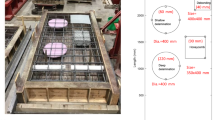Abstract
The high requirements for the reliability of pile foundations define the need for robust non-destructive quality control procedures. The low strain test is a widespread, quick, and relatively inexpensive method for pile integrity testing. The method is based on the analysis of elastic waves which are induced and registered on the pile head surface. To study the resolution of the test method, an experimental site of 10 cast-in-place piles with pre-fabricated defects was initiated. The field testing with a low-frequency input force pulse did not permit the identification of the flaws. To explore further, the numerical simulations using the finite element method were performed. Numerical simulation results show that the resolution of the test method increases for shorter input pulses which can be generated by light hammers with a hard head material. However, the input pulses with remarkably high-frequency content can be the reason for the signal anomalies, unrelated to pile integrity. The simulations show that the defect detectability depends on its location. The flaws near the pile top can go undetected or result in unexpected anomalies of low strain test data. To ensure the proper data collection and analysis, a set of few hammers of different weights and head materials should be used during the field testing.







Similar content being viewed by others
References
Fleming K, Weltman A, Randolph M, Elson K (2008) Piling engineering. Taylor & Francis, London. https://doi.org/10.1201/b22272
Loseva ES, Osokin AI, Mironov DA, Dyakonov IP (2020) Specific features of the construction and quality control of pile foundations in engineering and geological conditions of Saint Petersburg. Architect Eng 5:38–45
Sarhan HA, O’Neill MW, Tabsh SW (2004) Structural capacity reduction for drilled shafts with minor flaws. ACI Struct J 101(3):291–297
Amir JM (2017) Pile integrity testing: history, present situation, and future agenda. In: Proceeding 3rd Bolivian international conference on deep foundations, Santa Cruz de la Sierra, Madison, pp 17–32
Amir JM (2020) Integrity Testing, 2nd ed. https://www.piletest.com/show.asp?id=Engineer. Accessed 20 July 2021
Brettmann T, Hertlein B, Meyer M, Whitmire B (2011) Guideline for interpretation of nondestructive integrity testing of augered cast-in-place and drilled displacement piles. Deep Foundations Institute, Hawthorne
Lozovsky IN, Zhostkov RA, Churkin AA (2020) Numerical simulation of ultrasonic pile integrity testing. Russ J Nondestruct Test 56:1–11. https://doi.org/10.1134/S1061830920010064
Loseva ES, Osokin AI, Kopteva AI (2020) Features of underground space formation at the base of high-rise buildings. IOP Conf Ser: Mater Sci Eng 775:012025. https://doi.org/10.1088/1757-899X/775/1/012025
ASTM D5882–16 (2016) Standard test method for low strain impact integrity testing of deep foundations
Zheng C, Kouretzis GP, Ding X, Liu H, Poulos HG (2015) Three-dimensional effects in low-strain integrity testing of piles: analytical solution. Can Geotech J 53(2):225–235. https://doi.org/10.1139/cgj-2015-0231
Likins G, Rausche F (2000) Recent advances and proper use of PDI low strain pile integrity testing. In: Proceedings of the 6th international conference on the application of stress-wave theory to piles, Sao Paulo, pp 211–218.
Cui D-M, Yan W, Wang X-Q, Lu L-M (2017) Towards intelligent interpretation of low strain pile integrity testing results using machine learning techniques 17(11):2443. https://doi.org/10.3390/s17112443
Kim H-J, Mission JL, Dinoy PR, Kim H-S, Park T-W (2020) Guidelines for impact echo test signal interpretation based on wavelet packet transform for the detection of pile defects. Appl Sci 10(7):2633. https://doi.org/10.3390/app10072633
Churkin AA, Kapustin VV, Lozovsky IN, Zhostkov RA (2021) Research of the influence of the parameters of the “pile-soil” system on the dynamic attributes of the acoustic signal using numerical simulation. Bull Tomsk Polytech Univ Geo Assets Eng 332(1):129–140
Raushe F, Ren-Kung S, Likins GE (1991) Comparison of pulse echo and transient response pile integrity test methods. Integrity testing of foundations. Transportation Research Board, Washington, D.C., pp 21–27
Chai H-Y, Phoon K-K (2013) Detection of shallow anomalies in pile integrity testing. Int J Geomech 13:672–677. https://doi.org/10.1061/(ASCE)GM.1943-5622.0000233
Zhostkov RA (2019) Programma dlya modelirovaniya issledovaniya buronabivnykh svay poverkhnostnym seysmoakusticheskim metodom (a software for simulation of low integrity testing for cast-in-place piles). Patent RF 2019665449.
David RL, ed. (Internet Version 2007) CRC Handbook of Chemistry and Physics (87th Edition). http://www.hbcpnetbase.com
Briaud JL (2013) Geotechnical Engineering: Unsaturated and Saturated soils
Tsukanov AA, Kalabukhov DI, Romanov AI, Gorbatikov AV, Serdobolskaya ML, Grachev EA (2010) Modelirovaniye voln Releya v neodnorodnoy srede s ispol’zovaniyem vychislitel’nykh sistem s parallel’noy arkhitekturoy (Modeling Rayleigh waves in a non-homogeneous environment using computer systems with parallel architecture). Moscow State University, Moscow
Amestoy PR, Duff IS, Excellent J-Y (2000) Multifrontal parallel distributed symmetric and unsymmetric solvers. Comput Methods Appl Mech Eng 184:501–520. https://doi.org/10.1016/S0045-7825(99)00242-X
Acknowledgments
The authors would first and foremost like to thank LLC Geosfera and LLC SuperDrill Technology for their technical support. We would like to acknowledge chief engineer of LLC SuperDrill Technology Mironov Daniil for organization of field works and the head of LLC Geosfera Osokin Anatoliy for funding our study. The authors are also grateful to Alexei Churkin (NIIOSP) for his constructive suggestions and comments.
Funding
The research leading to these results received funding from State Tasks for the Geoelectromagnetic Research Center and the Schmidt Institute of Physics of the Earth of the Russian Academy of Sciences. The field experiments were funded by LLC Geosfera and LLC SuperDrill Technology.
Author information
Authors and Affiliations
Corresponding author
Ethics declarations
Conflict of interest
The authors declare that they have no known competing financial interests or personal relationships that could have appeared to influence the work reported in this paper.
Additional information
Publisher's Note
Springer Nature remains neutral with regard to jurisdictional claims in published maps and institutional affiliations.
Rights and permissions
About this article
Cite this article
Loseva, E., Lozovsky, I. & Zhostkov, R. Identifying Small Defects in Cast-in-Place Piles Using Low Strain Integrity Testing. Indian Geotech J 52, 270–279 (2022). https://doi.org/10.1007/s40098-021-00583-y
Received:
Accepted:
Published:
Issue Date:
DOI: https://doi.org/10.1007/s40098-021-00583-y




